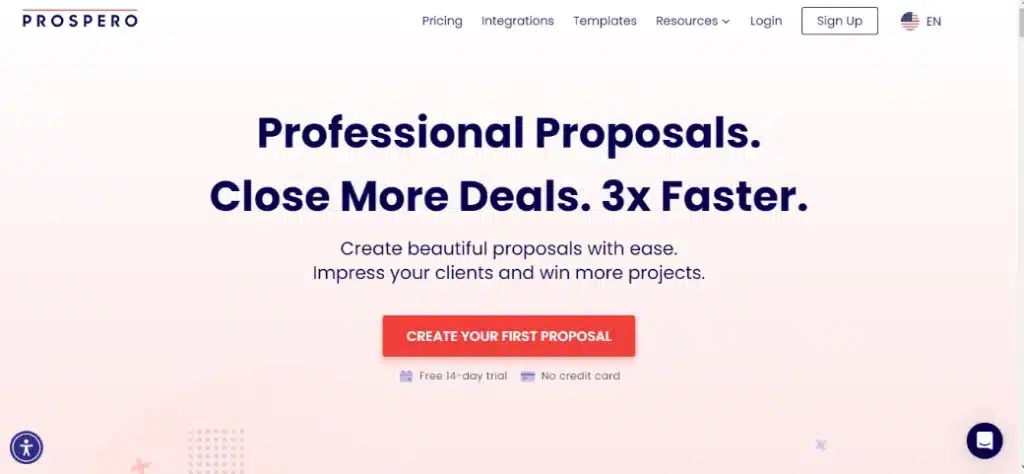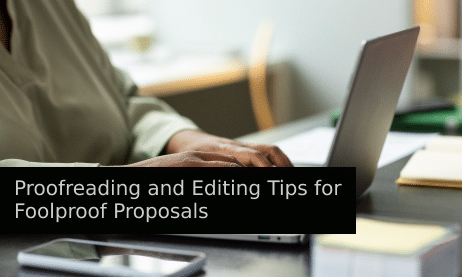Attention to detail is important when writing a business proposal. A well-written proposal can be the key to project approval and ultimate success, while one riddled with errors can quickly derail your chances. Proofreading and editing are not just the final steps; they’re essential for ensuring your proposal shines. This blog post will guide you through transforming your proposal from good to great, leaving a lasting impression on the reader and boosting your odds of success.
Proofreading Essentials
Even the most meticulously written proposal can fall victim to sneaky errors. Here’s what to watch out for during your proofreading deep dive:
- Grammar Errors: Watch out for typos, grammatical mistakes, punctuation errors, subject-verb agreement issues, missing commas, and misplaced apostrophes. A little vigilance can keep these errors at bay.
- Formatting Inconsistencies: Formatting inconsistencies can create a visually jarring experience for the reader. Ensure consistent font styles, margins, spacing, and bullet points throughout the proposal. Remember, a polished presentation reinforces professionalism.
- The Writing Style: Maintaining a consistent style is key. Are you using American or British English? Formal or informal tone? Once you establish your style, stick to it throughout the document to ensure a clear and unified voice.
- Industry Jargon: While some technical terms might be necessary, avoid excessive industry jargon. If you must use specialized terms, clearly define them for a broader audience. Aim for clear and concise language that conveys your expertise without alienating the reader.

Effective Proofreading Techniques
Proofreading is more than just hunting for typos. Here are some battle-tested techniques to ensure your proposal shines:
- Multiple Rounds, Multiple Benefits: Don’t just proofread once. Read through your proposal several times, with breaks in between. This allows you to approach the text with fresh eyes each time, catching errors you might have missed before. Consider starting from the end and working your way back to the beginning. This can disrupt your usual reading pattern and help you spot mistakes you might otherwise gloss over.
- The Power of the Spoken Word: Reading your proposal aloud can be a game-changer. Hearing your words spoken reveals awkward phrasing, clunky sentences, and inconsistencies in flow and clarity. This technique allows you to identify areas that might sound confusing to the reader, even if they appear grammatically correct on paper.
- Tech Tools: Grammar and spell-checking tools are valuable allies, but don’t rely on them solely. These tools can miss certain errors, like misused words or stylistic inconsistencies. Use them as a starting point, but always double-check their suggestions with your own critical eye.
Editing for Clarity and Impact
A well-structured and organized business proposal is like a well-designed map – it guides the reader effortlessly to your destination. Here’s how to edit for clarity and impact:
- The Logical Journey: Ensure your proposal follows a clear and logical flow of ideas. Each section should build upon the previous one, leading the reader towards a compelling conclusion. Organize your arguments strategically, highlighting the strongest points first and addressing any potential counter-arguments head-on.
- Bridging the Gaps: Smooth transitions between sections are important for maintaining reader engagement. Use well-crafted transition words and phrases to signal shifts in topics and ensure a cohesive narrative. Imagine each section as a stepping stone, leading the reader seamlessly through your proposal’s key points.
- Information Architecture: Think of your proposal as a house – you want the information to be well-organized and easy to navigate. Utilize headings, subheadings, bullet points, and numbered lists to break down complex information and enhance readability. Remember, a visually clear document is easier to understand and leaves a positive impression. Also, consider using a proposal writing software like Prospero which has multiple proposal templates that makes it easy for you to get started on your proposal and reduces your chances of errors.

Language and Tone
The language you use in your proposal has the power to persuade, inform, and ultimately win over the reader. Here’s how to ensure your language and tone are on point:
- Clarity is King: Strive for concise and professional language that is easy to understand. Avoid overly complex sentences, jargon, and passive voice. Use active voice to convey a sense of authority and ownership over your ideas. Remember, your goal is to communicate complex information effectively, not to impress the reader with your vocabulary.
- Audience Awareness: The tone you adopt should be tailored to your audience. For a formal proposal to a corporate board, a professional and respectful tone is essential. However, if you’re pitching to a tech startup, a more conversational and enthusiastic tone might be appropriate. Understanding your audience and tailoring your language accordingly shows you’ve done your research and are invested in building a connection.
- Technical Jargon: Technical terms can be necessary to showcase your expertise, but avoid drowning your proposal in industry jargon. If you must use specialized terms, clearly define them for a broader audience. The goal is to strike a balance – demonstrating your knowledge without alienating the reader. Opt for clear and concise language that conveys your message effectively, even for those unfamiliar with your specific field.
Proofreading vs. Editing: Sharpening Your Tools
Proofreading and editing are often used interchangeably, but they serve distinct purposes in the proposal writing process. Here’s a breakdown of the key differences:
- Proofreading: Think of proofreading as the final polish before submitting your proposal. It’s a meticulous line-by-line inspection aimed at catching typos, grammatical errors, punctuation mistakes, and formatting inconsistencies. It ensures your proposal is free of technical blemishes that could distract the reader or undermine your professionalism.
- Editing: Editing goes beyond the surface level. It’s a more holistic approach that focuses on improving the overall structure, flow, and impact of your proposal. An editor will examine the organization of your arguments, ensure a logical flow of ideas, and suggest revisions to enhance clarity and persuasiveness. They might also suggest tightening language, eliminating unnecessary jargon, and tailoring the tone to resonate with your audience. Essentially, editing helps you craft a compelling narrative that effectively conveys your message and increases your chances of success.
In a nutshell: Proofreading is about catching errors, while editing is about crafting a clear and impactful message. Both are important steps in ensuring your proposal shines.

Advanced Tips and Tools: Supercharge Your Proofreading Arsenal
By now, you’re equipped with a solid foundation for proofreading and editing your proposal. But the journey doesn’t end there. Here are some advanced tips and tools to further streamline and elevate your process:
A. Leverage Technology
- Tech to the Rescue: Embrace the power of technology. Grammarly, Hemingway Editor, ProWritingAid, and other online tools can be valuable allies in your proofreading quest. These tools can help identify typos, grammatical errors, and clarity issues. Hemingway Editor, for instance, highlights overly complex sentences and suggests simpler alternatives. While these tools shouldn’t replace your critical thinking, they can be a great first line of defense and save you valuable time.
Pro Tip: Remember, these tools are best used in conjunction with your own judgment. They can flag potential issues, but the final decision on revisions rests with you.
B. Consider Getting a Second Pair of Eyes

Sometimes, even the most meticulous proofreading can miss hidden errors or areas for improvement. Here’s why involving a second pair of eyes can be a game-changer:
- Fresh Perspective: Having a trusted colleague or editor review your proposal can be incredibly beneficial. They bring a fresh perspective and might catch errors or awkward phrasing that you’ve simply become blind to after staring at the document for hours. A fresh set of eyes can also help identify areas where the clarity or flow could be improved.
- Expertise Advantage: Consider enlisting the help of someone with specific expertise in your field or proposal type. They can not only identify technical errors or inconsistencies but also ensure your message resonates with the target audience.
- Confidence Booster: Knowing that a second pair of eyes has reviewed your proposal can give you a much-needed confidence boost. It provides peace of mind and allows you to submit your work feeling assured that you’ve presented your best possible case.
Who to Involve: A trusted colleague familiar with your writing style can be a great option. Alternatively, consider hiring a professional editor or proofreader with experience in your industry.
Conclusion
Taking the time to thoroughly proofread and edit your proposal is an investment that pays off in spades. It demonstrates your professionalism, enhances the persuasiveness of your arguments, and ultimately increases your chances of securing that coveted approval.
By following these tips and investing in a thorough proofreading and editing process, you can transform your business proposal from good to great, leaving a lasting impression on the reader and significantly increasing your chances of success. So, take a deep breath, hit submit with confidence, and watch your well-written proposal pave the way to your next big project. To help you get started on your proposal writing consider signing up for Prospero today.




